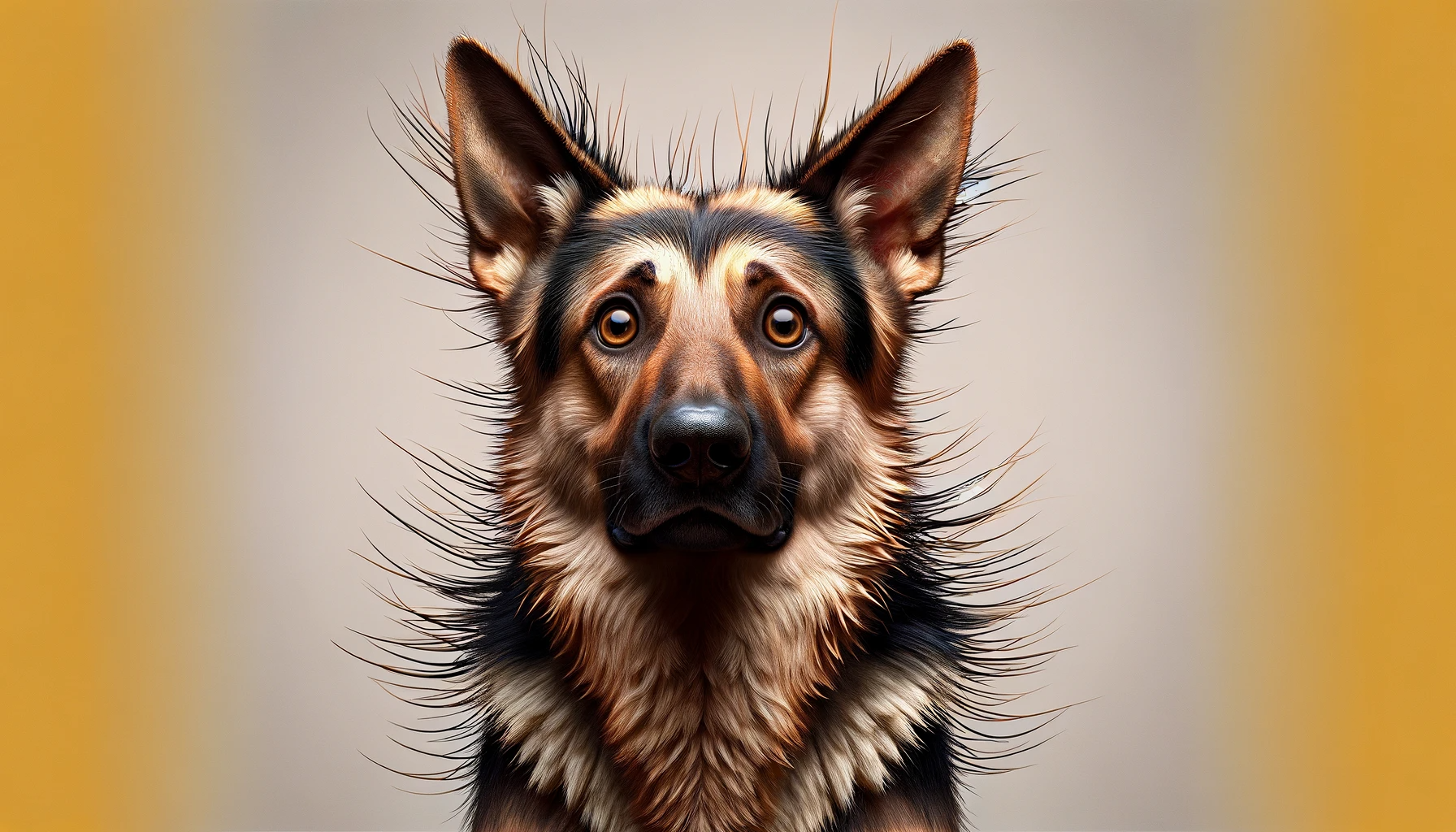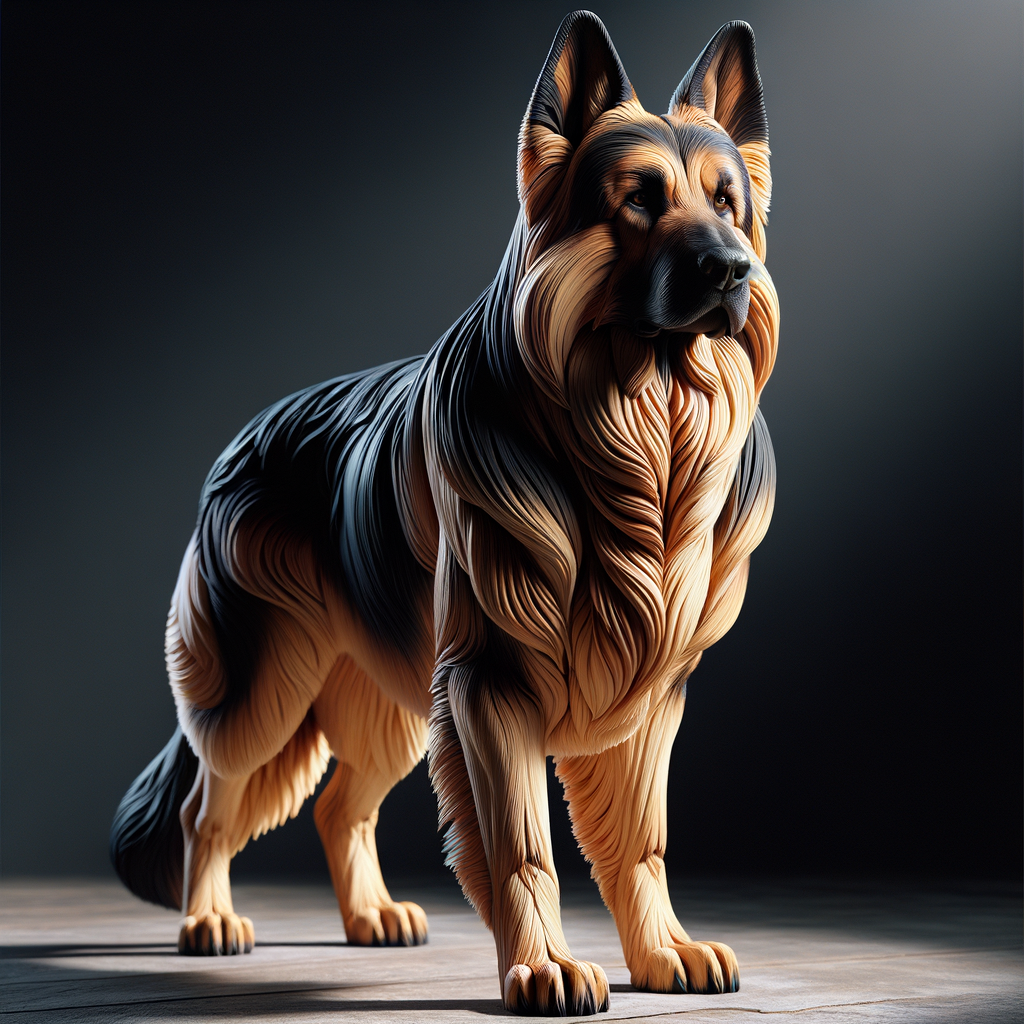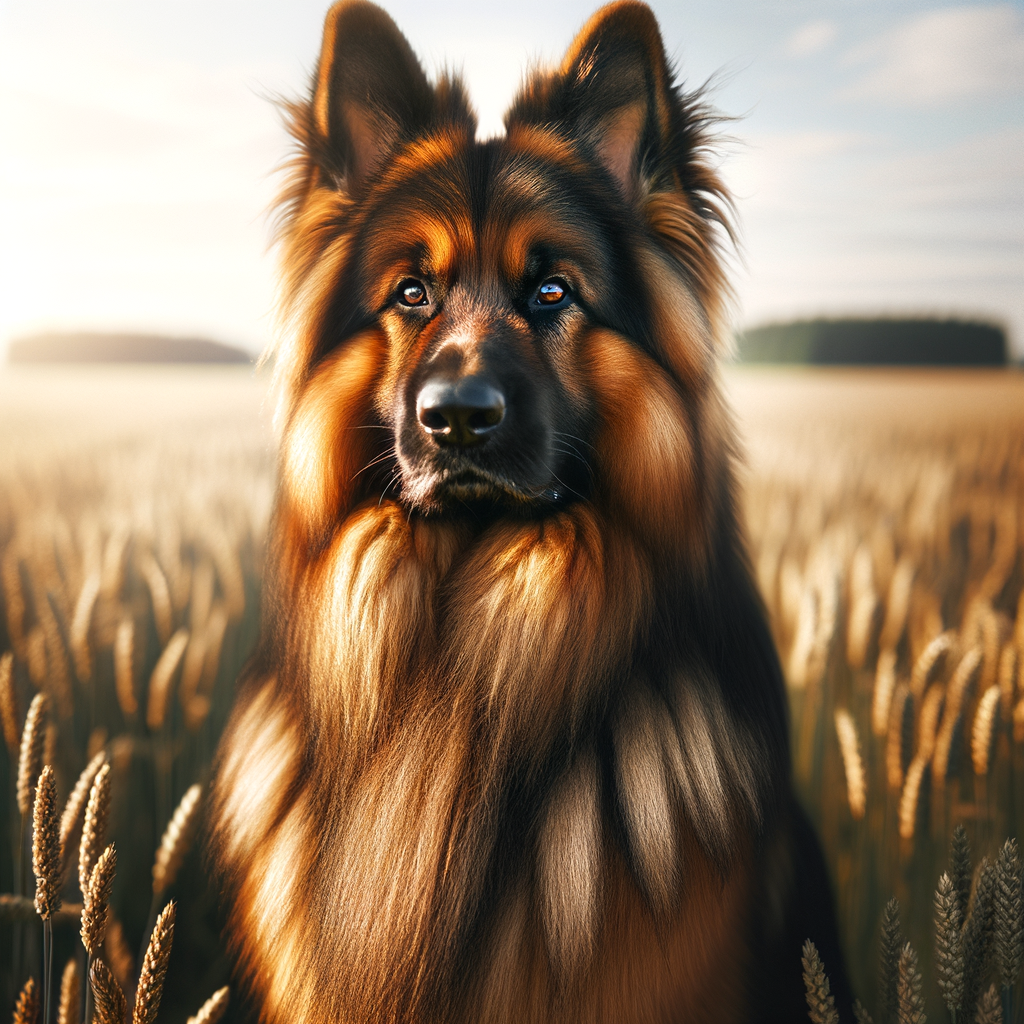If you’re a dog lover like me, you’ve probably seen your furry friend display a behavior known as raised hackles. It’s a fascinating phenomenon that serves as a window into your dog’s emotions and instincts. But what exactly are hackles, and what breeds are particularly known for this trait? I’m glad you’re asking!

Understanding the Psychological and Physical Aspects
When we talk about a dog’s hackles, we’re referring to the strip of hair running down their back, which can stand on end—a bit like our own goosebumps. This involuntary response is tied to the dog’s fight-or-flight instinct and communicates a range of emotions, from fear and anxiety to excitement and aggression. As a holistic vet, I always encourage dog parents to pay attention to this often overlooked body language as it can provide valuable insights into your pet’s mood and well-being.
Significance of Raised Hackles in Canine Communication
Raised hackles don’t necessarily mean that your dog is aggressive. Rather, it’s a clear, non-verbal way for dogs to express their emotional state to other dogs, animals, and even us humans. It’s their way of saying, “I’m on high alert,” or “I’m not comfortable with this situation.”
Now, let’s talk about which breeds are known for this captivating characteristic. While all dogs can raise their hackles, some breeds are more likely to do so due to their protective nature, size, or coat length.
Dog Breeds with Prominent Raised Hackles
Large breeds like Rottweilers, German Shepherds, Doberman Pinschers, and Rhodesian Ridgebacks often display raised hackles, especially when they feel threatened or excited. Their size and the length of their fur make the raised hackles quite noticeable. But don’t be mistaken, small to medium breeds can also show this phenomenon! Breeds like the Beagle, Border Collie, and Australian Shepherd, despite their smaller size, can also display prominent raised hackles when they’re stimulated.
In addition to paying attention to this behavior, understanding the individual personality of your dog’s breed can help you better interpret what they’re trying to say. For example, while a Rottweiler may raise its hackles to show dominance, a German Shepherd might do the same to indicate it’s ready to protect its pack.
As a dog parent, it’s crucial to understand your pet’s unique ways of expressing themselves. Dogs with raised hackles aren’t trying to intimidate—they’re simply communicating in the only way they know how. So next time you see this happen, remember, your pup is talking to you—make sure you’re listening!

The Science Behind Raised Hackles
Have you ever been amazed by the way your dog’s fur stands up when they’re excited or agitated? This spectacle isn’t just a unique visual cue; it’s a fascinating biological mechanism that plays a critical role in canine communication. As a holistic veterinarian, I’m here to guide you through the intriguing science behind raised hackles in various dog breeds.
Exploring the Biological Mechanism
Let’s dive into the biology first. The phenomenon of raised hackles, also known as piloerection, is triggered by the autonomic nervous system – the part of the nervous system that controls involuntary actions. Much like goosebumps in humans, dogs experience piloerection when tiny muscles at the base of each hair follicle contract. This reaction can be spurred by various emotional states, including excitement, fear, anxiety, or aggression.
Many breeds are known for their prominent hackles, but it’s important to note that all dogs possess this feature. The visibility of raised hackles varies depending on the dog’s coat length, density, and color. Some coats mask the raised hairs, making the hackles less noticeable. Regardless, this biological reaction happens in every breed, from the petite Chihuahua to the imposing Great Dane.
The Role of Hackles in Dog Behavior and Body Language
Moving on to behavior, raised hackles play a crucial role in canine communication. Dogs are creatures of body language, and every tail wag, ear position, and hair lift carries a message.
- Aggression: Raised hackles often occur when a dog feels threatened or challenged. The standing hair makes the dog appear larger and more intimidating to potential adversaries.
- Fear: Scared dogs can also display raised hackles. In this context, it’s a defensive tactic to look bigger and deter perceived threats.
- Excitement: Not all raised hackles signify negativity. Sometimes, dogs raise their hackles during play or when they’re particularly excited. This is common in high-energy breeds, like Border Collies and Siberian Huskies.
Being able to read and understand these signals can significantly enhance your relationship with your canine companion. Remember, though, that raised hackles are just one piece of the puzzle. It’s vital to consider other visual cues, such as body posture, facial expression, and tail positioning, for a complete assessment of your dog’s emotional state.
As we delve into the world of dog breeds with raised hackles, keep these insights in mind. Each breed has unique characteristics, temperaments, and behaviors that contribute to their hackle display. I hope this deeper understanding of the science behind raised hackles enriches your appreciation for these magnificent creatures and their expressive ways.
Dog Breeds with Raised Hackles: Intimidating Canines with a Bold Look
List of Dog Breeds with Prominent Raised Hackles
While all dogs possess the physical characteristics to raise their hackles, certain breeds are notably more prone to this behavior due to their inherent traits and nature. This section will delve into a list of such dog breeds, categorizing them into large and small to medium groups.
Large Breeds Known for Raised Hackles
– Rottweiler: Celebrated for their protective nature, Rottweilers often display raised hackles when they sense danger or a threat to their family. Their hackles, running from their neck to their tailbase, become more visible when they are agitated or excited.
– German Shepherd: Intelligent and highly trainable, German Shepherds tend to raise their hackles during heightened emotional states, including fear, excitement, or aggression. The prominent line of hair along their spine visibly bristles when these dogs are alert or concerned.
– Doberman Pinscher: Known for their sleek physique and sharp intelligence, Dobies often raise their hackles in response to potential threats. Their hackles, running from the base of the neck to the tail, provide a clear indication of their mental state.
– Rhodesian Ridgeback: Named for the unique ‘ridge’ of hair running down their back, Ridgebacks naturally have a raised line of hair along their spine. This ridge can rise further during moments of excitement or agitation.
Small to Medium Breeds with Noticeable Hackles
– Beagle: Despite their friendly demeanor, Beagles aren’t shy about raising their hackles. While hunting or tracking a scent, a beagle may raise its hackles to express excitement or focus.
– Border Collie: Known for their herding skills and intelligence, Border Collies may display raised hackles when they are working or in an intense situation.
– Shiba Inu: This Japanese breed is known for its bold and spirited nature. Shiba Inus may raise their hackles in response to excitement, surprise, or potential threats.
– Jack Russell Terrier: These energetic dogs often raise their hackles during play, excitement, or when they feel threatened. Despite their small size, they can be quite assertive and aren’t afraid to show it!
Remember, while certain breeds may be more predisposed to raising their hackles than others, individual behavior can vary greatly. Regular grooming can also affect the visibility of raised hackles. Understanding your dog’s unique body language, including the position of their hackles, can help you better understand their emotions and communicate more effectively with your furry friend.
Dog Breeds with Raised Hackles: Intimidating Canines with a Bold Look
The Rottweiler: A Breed with an Intimidating Presence
Physical Characteristics of Rottweilers
Known for their robust and muscular structure, Rottweilers are one of the most distinct dog breeds with raised hackles. They are large, with males standing 24-27 inches tall and weighing around 95 to 130 pounds, while females are slightly less in size and weight. Their coat is typically black with rust to mahogany markings. As for the hackles, they are particularly prominent along the spine and neck area, giving them an imposing look when raised.
Behavioral Traits and Hackles Display in Rottweilers
The Rottweiler is a confident, calm, and courageous breed. They form strong bonds with their families and are protective, traits that stem from their past as working dogs used for herding and guarding. The raised hackles in a Rottweiler can be a clear display of their alertness and readiness to protect their territory or loved ones.
It’s important to remember that raised hackles in Rottweilers do not always signify aggression. Yes, they may rise as a response to perceived threats, but they can also be a sign of excitement, curiosity, or anxiety. Just as humans experience ‘goosebumps’ in response to various emotions, Rottweilers’ hackles can rise due to a range of emotions too.
As a Rottweiler owner, it’s crucial to understand the context and body language cues accompanying the raised hackles. For instance, if the hackles are up, and the Rottweiler is displaying other signs of aggression like growling, baring teeth, or a stiff body posture, then it’s a clear signal of a threat. However, if the hackles are up, and the dog is wagging its tail, it might be due to excitement or happiness.
Proper training and socialization can help manage and understand the hackles display in Rottweilers better. Remember, each Rottweiler is unique, and understanding their individual behaviors is key to building a healthy relationship with this breed.
Now that you know more about Rottweilers, their physical characteristics, and how they use their raised hackles to communicate, you can better understand and respond to their needs. And while a Rottweiler’s raised hackles can seem intimidating, they’re simply a part of this loyal, protective breed’s many fascinating features.

The German Shepherd: A Versatile and Protective Breed
The German Shepherd is a breed that is often associated with raised hackles, a physical trait that can be quite intimidating. But don’t let this characteristic fool you; these dogs are known for their versatility and protective nature, making them one of the most beloved breeds worldwide.
Distinctive Features of German Shepherds
German Shepherds are large, strong dogs, typically weighing between 50 to 90 pounds. They have a distinctive look, characterized by a domed forehead, long snout, and large, intelligent eyes. Their coat is dense and comes in a variety of colors, including black, sable, and black and tan.
One of the most notable features of a German Shepherd is their stance. They stand tall and confident, with a body that’s slightly longer than it is tall. When their hackles are raised, it adds to their imposing presence, making them appear even more formidable.
Understanding Hackles in German Shepherd Behavior
Like many dog breeds with raised hackles, German Shepherds use this physical feature as a form of communication. When a German Shepherd raises its hackles, it’s usually a sign that the dog is experiencing a strong emotional response. This could be fear, excitement, aggression, or even curiosity. It’s a way for the dog to make itself look bigger and more intimidating, often in response to a perceived threat.
Here are a few scenarios where a German Shepherd might raise its hackles:
- When they sense danger: German Shepherds are known for their protective nature. If they sense a threat to their family, their hackles might rise as they prepare to defend their loved ones.
- During play: Sometimes, a German Shepherd might raise its hackles during play. This is usually a sign of excitement and is not a cause for concern.
- When they’re nervous or scared: If a German Shepherd is in a new environment or facing a situation they’re not comfortable with, their hackles might rise. This is a sign of fear or anxiety.
Understanding the context in which a German Shepherd raises its hackles is crucial. It’s a form of communication, and interpreting it correctly can help you understand your dog’s needs and emotions better.
Remember, a German Shepherd with raised hackles isn’t necessarily aggressive or dangerous. It’s simply a dog that’s experiencing a strong emotional response. As a responsible dog parent, it’s your job to understand and respond to these signals in a way that ensures your dog’s comfort and well-being.
The Doberman Pinscher: Sleek and Powerful Canines
When we talk about dog breeds with raised hackles, the Doberman Pinscher cannot be overlooked. Dobermans, renowned for their sleek coat, muscular build, and energetic nature, are in the group of dog breeds that display raised hackles more prominently.
The Doberman’s Physical Profile
Doberman Pinschers have a noble and powerful presence. Their body is compact and muscular, designed for speed and endurance. The Dobie’s coat is short, smooth, and comes in a range of colors including black, red, blue, and fawn, often with rust-colored markings. Their expressive ears, usually cropped, and their tail, often docked, give them an alert and intimidating appearance.
Yet, perhaps the most telling sign of a Doberman’s mood is the hair along their back. When a Doberman feels threatened, excited, or anxious, the hair in this area, known as the hackles, may stand up. This is a primal response designed to make the canine look bigger and more threatening to potential foes.
Hackles as a Sign of Alertness in Dobermans
Dobermans, like many other breeds, raise their hackles as a sign of alertness or arousal. This is not necessarily a sign of aggression as is commonly perceived. Instead, it’s a form of communication, signaling that the dog is in a heightened state of awareness.
When the hackles of a Doberman rise, it may be due to various factors. It could be a response to an unfamiliar situation, person, or animal. It can also be a reaction to certain sounds or environmental changes. In some cases, it may even be a sign of fear or submission, contrary to what many people think.
It’s crucial, as a Doberman owner, to be familiar with your dog’s body language. Raised hackles, combined with other signals such as stiff posture, growling, or showing of teeth, could indicate aggressive behavior. However, raised hackles in conjunction with tail wagging, excitement, or playful behavior signifies a completely different emotion.
Remember, just like humans, each Doberman is unique. Raised hackles can mean different things depending on the situation and individual dog’s character. So, understanding your Doberman’s body language is key to interpreting their feelings and needs correctly.
As a pet parent, it’s important for us to not just love and provide for our furry friends, but to truly understand them. This way, we can ensure that we’re meeting their emotional needs and fostering a strong, trusting bond. After all, communication is a two-way street, even with our four-legged companions!

The Rhodesian Ridgeback: A Breed with a Natural Ridge
Every dog breed possesses its unique set of characteristics, and the Rhodesian Ridgeback is no exception. When it comes to dog breeds with raised hackles, this breed stands out with its naturally occurring ridge that starts behind the shoulders and runs down along the length of the spine, setting it apart from other breeds.
The Unique Ridge of Rhodesian Ridgebacks
The ridge in the Rhodesian Ridgeback is made up of hair that grows in the opposite direction to the rest of the coat. It’s a defining feature of the breed and is formed by two whorls of hair, known as ‘crowns’, located just behind the shoulders. This ridge can raise or lower depending on the dog’s emotional state, much like hackles in other breeds. In fact, a well-defined ridge is one of the breed standards for the Rhodesian Ridgeback.
Here’s a quick look at the Rhodesian Ridgeback’s key features:
- Breed Type: Hound
- Size: Large
- Temperament: Loyal, Intelligent, Dignified
- Defining Feature: A distinct ridge on the back
Raised Hackles and the Ridgeback’s Temperament
The Rhodesian Ridgeback is known for its calm and reserved temperament. These dogs are loyal to their families, intelligent, and have a dignified presence that can be quite captivating. When a Ridgeback raises its hackles—or rather, its ridge—it usually indicates a heightened level of arousal, be it excitement, fear, or aggression.
Just like in other dog breeds with raised hackles, this behavior is essentially a form of communication. In the wild, dogs raise their hackles to appear larger and more intimidating to potential threats. In domestic dogs, this behavior can be triggered by various stimuli, including unfamiliar people, other dogs, or unusual situations.
However, it’s important to remember that every dog is an individual, and not all dogs with raised hackles are necessarily aggressive or fearful. Just like how humans have different ways of expressing their feelings, dogs also have their unique mannerisms.
Ultimately, understanding your dog’s body language, including the significance of raised hackles, can greatly enhance the bond you share with your pet while ensuring their comfort and well-being.
Training and socializing dogs, especially those breeds known for raised hackles, is critical. A proper understanding of their body language and behavior is vital to ensure a healthy and harmonious environment for both the pet and the owner. Raised hackles, often seen in breeds such as Rottweilers, German Shepherds, Dobermans, and Rhodesian Ridgebacks, can be a sign of various emotions including excitement, fear, aggression, or alertness. Thus, knowing how to manage such displays through effective training and socialization techniques is important.
The Importance of Proper Training Techniques
While all dogs require training, breeds prone to raised hackles may need a bit more attention. This is not due to any inherent aggressiveness, but rather to ensure that their body language is properly understood and managed. The goal is to teach your dog to be calm, confident, and well-behaved under various situations.
- Consistency: Dogs learn best when there is consistency in commands and responses. Consistency helps them understand what is expected of them and how to behave.
- Positive Reinforcement: Rewards for good behavior are far more effective than punishments for bad behavior. Positive reinforcement could be treats, praises, or petting. This encourages the dog to repeat good behavior.
- Patience: Training takes time. It’s important to be patient with your pup and give them enough time to learn and understand commands.
Socialization Strategies to Manage Hackles Display
Socializing your dog from a young age is crucial, especially for breeds with prominent hackles. It helps them get used to different environments, people, and other animals, which can significantly reduce the likelihood of their hackles raising out of fear or aggression.
- Early Exposure: Introduce your dog to various environments, people, and other animals at a young age. This will help them feel more comfortable in different situations.
- Gradual Introduction: Don’t overwhelm your dog with too many new things at once. Gradual introductions allow your dog to adapt slowly and comfortably.
- Monitor Interactions: Watch your dog’s interactions closely. If they seem uncomfortable or their hackles raise, remove them from the situation. Over time, they will learn to stay calm in various situations.
It’s important to remember that a dog’s hackles are a natural part of their body language, and not necessarily a sign of aggression. Training and socializing your dog effectively will go a long way in ensuring that you understand their body language and can respond appropriately.
As a pet parent, you are your dog’s best teacher and friend. Your love, patience, and understanding of your dog’s unique qualities – like their raised hackles – are what will guide them to be the best they can be. So, whether you own a German Shepherd or a Rhodesian Ridgeback, remember to embrace their unique characteristics, and use them as tools to enhance your bond. Your relationship with your pet is a journey, one filled with learning, growth, and a lot of love. So, embrace every part of it – hackles and all!
Frequently Asked Questions
Q1: What does it mean when a dog has raised hackles?
A: Raised hackles, also known as piloerection, is a physiological response in dogs where the hair along the dog’s back stands up. This is often a sign of arousal, which can be due to excitement, fear, aggression, or other intense emotions.
Q2: Are certain dog breeds more likely to have raised hackles?
A: While any dog can exhibit raised hackles, it is more noticeable in breeds with longer hair along their spine. However, it’s important to note that this is a behavioral response, not a breed-specific trait.
Q3: Is a dog with raised hackles always aggressive?
A: No, raised hackles do not always indicate aggression. While it can be a sign of aggression, it can also be a response to excitement, fear, or other intense emotions. It’s important to look at the overall body language of the dog to understand its mood and intentions.
Q4: What should I do if a dog with raised hackles approaches me?
A: If a dog with raised hackles approaches you, it’s important to stay calm and avoid making sudden movements. Do not make direct eye contact with the dog as this can be seen as a threat. If the dog’s body language indicates aggression, try to slowly and calmly move away.
Q5: Can training affect a dog’s tendency to raise its hackles?
A: Yes, training can help manage a dog’s emotional responses and potentially reduce the frequency of raised hackles. However, it’s a natural response and can’t be completely eliminated. It’s important to work with a professional dog trainer to address this behavior if it becomes a concern.
Dr. Candy, a holistic veterinarian and certified raw dog food nutrition specialist, graduated from Oklahoma State University in 2009 with a DVM and has since specialized in companion animal nutrition, advocating for species-specific diets. With a background in wildlife rehabilitation and oil spill response, she combines holistic health and conventional medicine in her unique approach to treating chronic diseases, allergies, and autoimmune conditions in pets. As the owner of a veterinary practice in Colorado and an author, Dr. Candy is dedicated to educating pet parents and improving the health and happiness of animals.




